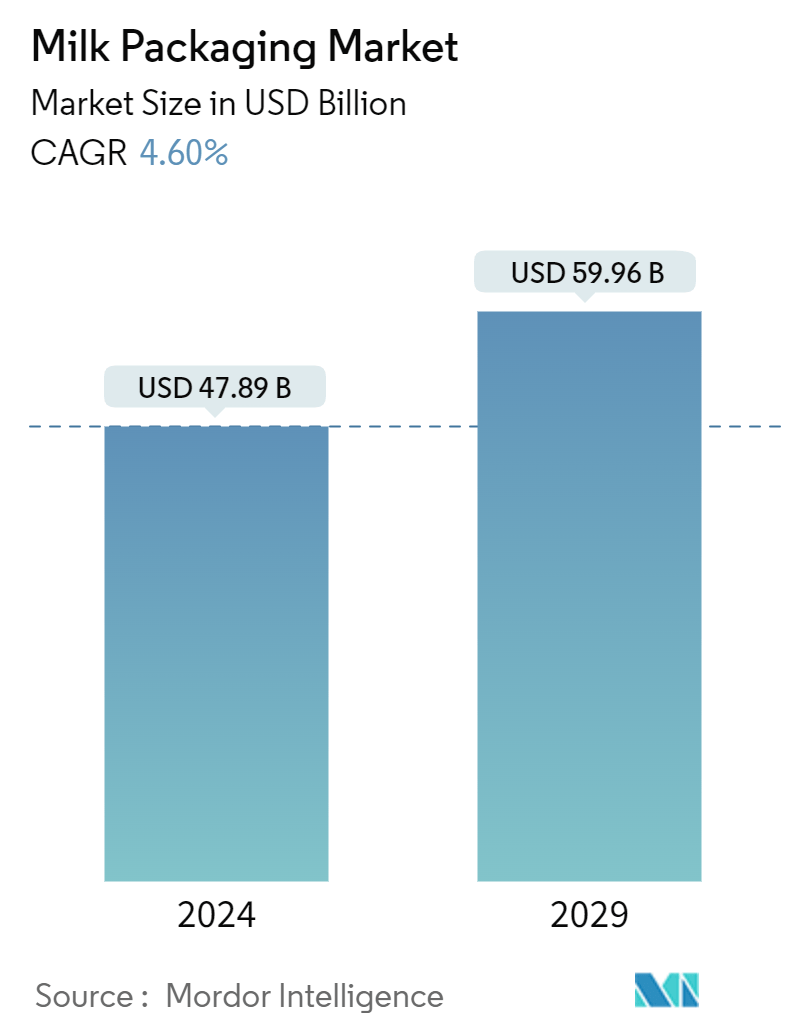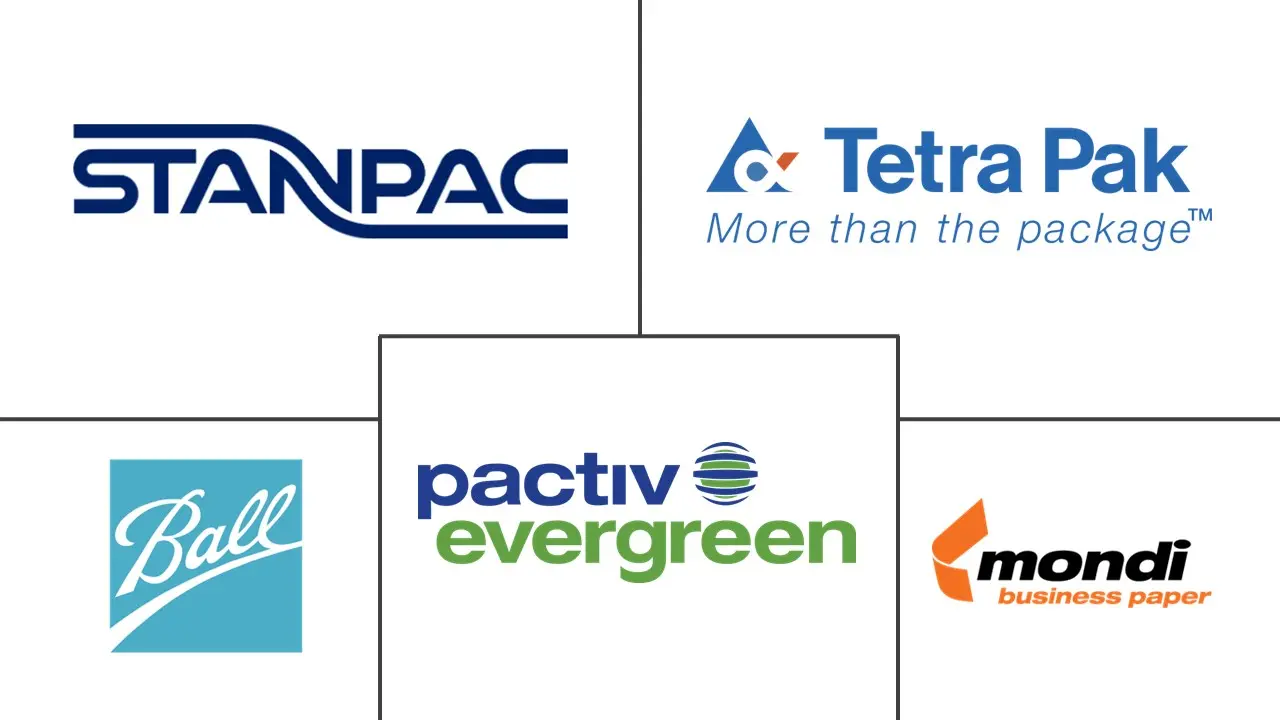Market Size of Milk Packaging Industry

| Study Period | 2019 - 2029 |
| Market Size (2024) | USD 47.89 Billion |
| Market Size (2029) | USD 59.96 Billion |
| CAGR (2024 - 2029) | 4.60 % |
| Fastest Growing Market | Asia Pacific |
| Largest Market | North America |
| Market Concentration | Low |
Major Players
*Disclaimer: Major Players sorted in no particular order |
Milk Packaging Market Analysis
The Milk Packaging Market size is estimated at USD 47.89 billion in 2024, and is expected to reach USD 59.96 billion by 2029, growing at a CAGR of 4.60% during the forecast period (2024-2029).
Milk packaging is essential to protect milk from contamination, spoilage, and degradation by blocking out light, air, and bacteria, thereby extending its shelf life. Proper packaging ensures that milk remains hygienic and safe for consumption by preventing leaks and tampering. With increasing emphasis on environmental impact, packaging innovations focus on using recyclable or biodegradable materials to reduce waste.
- Milk stands as the world's most consumed dairy product. Due to its high moisture and mineral content, vendors face challenges in long-term storage. This difficulty is a primary reason why milk is often traded in forms like milk powder or processed variants. Over 70% of fresh milk is currently packaged in HDPE bottles, diminishing the demand for traditional glass bottle packaging. Factors such as the rise of on-the-go consumption, the convenience of easy pouring, appealing packaging aesthetics, and heightened health awareness evident in the popularity of drinkable dairy alternatives such as soy-based products and sour milk have collectively fueled the demand for innovative milk packaging solutions.
- According to FAO, global milk production is projected to grow by 177 million metric tons by 2025. Also, as reported by NDDB, the western region of India topped the charts in milk procurement for the financial year 2023, averaging over 31 million kg daily. Meanwhile, the southern region secured the second spot, with an average daily procurement exceeding 15 million kg. As lifestyles evolve and urbanization accelerates, consumers are increasingly favoring dairy products over cereals as their primary protein source. This shift is projected to bolster the demand for dairy products, particularly milk, in the coming years. Consequently, these trends are poised to shape the dynamics of the milk packaging market.
- Furthermore, bio-based packages are more sustainable than standard milk cartons, reducing the manufacturer's reliance on fossil-based polyethylene plastic in the lining. With increasing emphasis on environmental impact, packaging innovations focus on using recyclable or biodegradable materials to reduce waste. For instance, in July 2023, Arla Foods partnered with Blue Ocean Closures to develop a fiber-based cap for its milk cartons to cut its plastic consumption by over 500 tonnes yearly. Further, in November 2023, addressing concerns surrounding plastic waste, Freshways launched its LoveMilk brand in 1 liter, 500 ml, and 1-pint Pure-Pak cartons with a new tethered cap. This initiative is being rolled out in the foodservice and wholesale industries.
- However, concerns over the harmful impacts of plastics and non-biodegradable packaging materials have arisen among consumers and manufacturers. In response, companies are shifting toward environmentally friendly biodegradable packaging. Manufacturers are adopting green packaging methods, focusing on lighter materials and encouraging recycling. Furthermore, environmental regulations are anticipated to affect milk production. This is because greenhouse gas emissions from milk packaging account for a notable portion of total emissions in certain countries, making them susceptible to changes in related regulations.
- The ongoing conflict between Russia and Ukraine significantly impacts the growth of the milk packaging market. Damaged infrastructure and transportation hurdles due to the war disrupt the supply chains for both raw and packaging materials. This disruption raises the specter of shortages and inflated costs. Furthermore, the conflict-induced surge in energy prices and inflation could escalate production and packaging expenses, subsequently affecting the pricing and accessibility of milk products.
Milk Packaging Industry Segmentation
Milk packaging is essential to protect, carry, market, and sustain its freshness and convenience. Several reasons exist for ensuring the durable packaging of milk, such as safety, information, ease of storage and handling, and avoiding distribution damages.
The milk packaging market is segmented by packaging type (cans, bottles/containers, cartons, pouches/bags, and other packaging types), material (plastic, paperboard, and other materials), and geography (North America, Europe, Asia-Pacific, Latin America, and Middle East and Africa). The market sizes and forecasts are provided in value (USD) for all the above segments. The impact of macroeconomic trends on the market is also covered under the scope of the study. Further, the disturbance of the factors affecting the market's evolution in the near future, such as drivers and constraints, has been covered in the study. The market sizes and forecasts are provided in terms of value (USD) for all the above segments.
| By Packaging Type | |
| Cans | |
| Bottles/Containers | |
| Cartons | |
| Pouches/Bags | |
| Other Packaging Types |
| By Material | |
| Plastic | |
| Paperboard | |
| Other Materials |
| By Geography | |
| North America | |
| Europe | |
| Asia-Pacific | |
| Latin America | |
| Middle East and Africa |
Milk Packaging Market Size Summary
The milk packaging market is poised for significant growth, driven by increasing consumer demand for eco-friendly and sustainable packaging solutions. As milk remains the most consumed dairy product globally, the challenge of preserving its freshness and quality over time has led to a shift towards innovative packaging materials. The market is witnessing a trend towards the use of HDPE bottles, aseptic cartons, and bio-based packages, which offer convenience and sustainability. The growing popularity of flavored milk and the trend of on-the-go consumption are further propelling the demand for advanced packaging solutions. Additionally, the rising awareness of environmental issues is encouraging manufacturers to adopt greener packaging techniques, such as paperboard packaging, which is expected to be the fastest-growing segment due to its recyclable properties.
In the Asia-Pacific region, the milk packaging market is experiencing robust growth due to increasing disposable incomes, urbanization, and a shift towards protein-based diets. The region's high potential for lactose-free dairy products and the growing concerns over child nutrition are contributing to the market's expansion. The availability of packaged dairy products through various retail channels is also on the rise, supporting the adoption of dairy-based packaging. The market is highly competitive and fragmented, with key players like Evergreen Packaging LLC, Stanpac Inc., Elopak AS, Tetra Pak International SA, and Ball Corporation continuously innovating to meet the evolving consumer preferences. Collaborations and investments in sustainable packaging technologies are further enhancing the market's growth prospects, as companies strive to reduce their environmental footprint and cater to the increasing demand for eco-friendly packaging solutions.
Milk Packaging Market Size - Table of Contents
-
1. MARKET DYNAMICS
-
1.1 Market Overview
-
1.2 Market Drivers
-
1.2.1 Rising Health Concerns Among Consumers
-
1.2.2 Increasing Consumption of Flavored Milk
-
-
1.3 Market Restraints
-
1.3.1 Greenhouse Gas Emissions due to Dairy Activities Leading to Legislative Issues
-
-
1.4 Industry Value Chain Analysis
-
1.5 Industry Attractiveness - Porter's Five Forces Analysis
-
1.5.1 Bargaining Power of Suppliers
-
1.5.2 Bargaining Power of Buyers
-
1.5.3 Threat of New Entrants
-
1.5.4 Threat of Substitute Products
-
1.5.5 Intensity of Competitive Rivalry
-
-
1.6 Assessment of the Impact of Microeconomic Factors on the Market
-
-
2. MARKET SEGMENTATION
-
2.1 By Packaging Type
-
2.1.1 Cans
-
2.1.2 Bottles/Containers
-
2.1.3 Cartons
-
2.1.4 Pouches/Bags
-
2.1.5 Other Packaging Types
-
-
2.2 By Material
-
2.2.1 Plastic
-
2.2.2 Paperboard
-
2.2.3 Other Materials
-
-
2.3 By Geography
-
2.3.1 North America
-
2.3.2 Europe
-
2.3.3 Asia-Pacific
-
2.3.4 Latin America
-
2.3.5 Middle East and Africa
-
-
Milk Packaging Market Size FAQs
How big is the Milk Packaging Market?
The Milk Packaging Market size is expected to reach USD 47.89 billion in 2024 and grow at a CAGR of 4.60% to reach USD 59.96 billion by 2029.
What is the current Milk Packaging Market size?
In 2024, the Milk Packaging Market size is expected to reach USD 47.89 billion.

